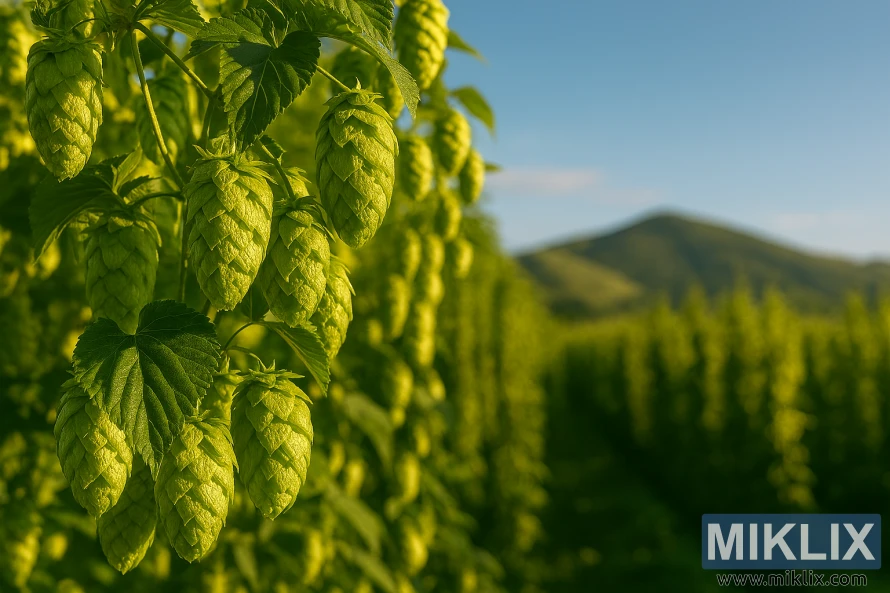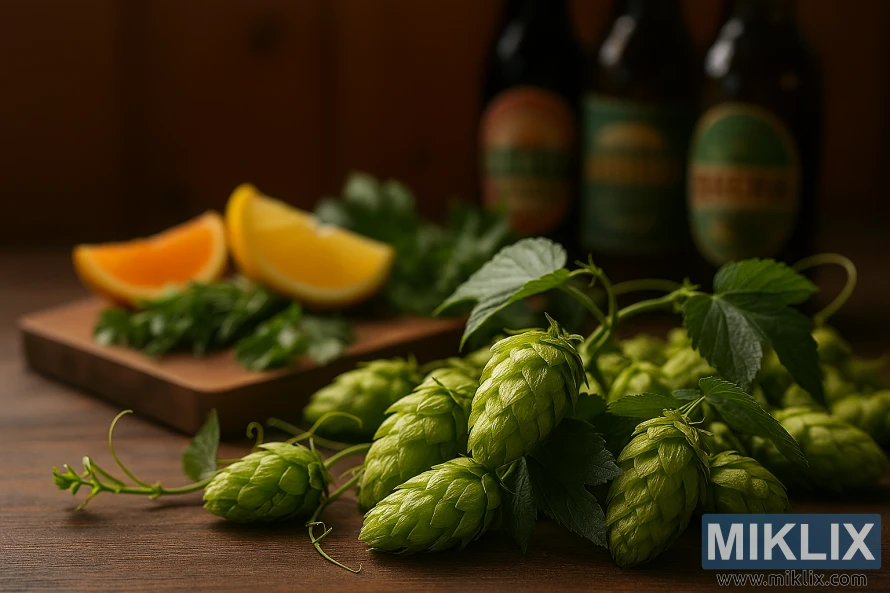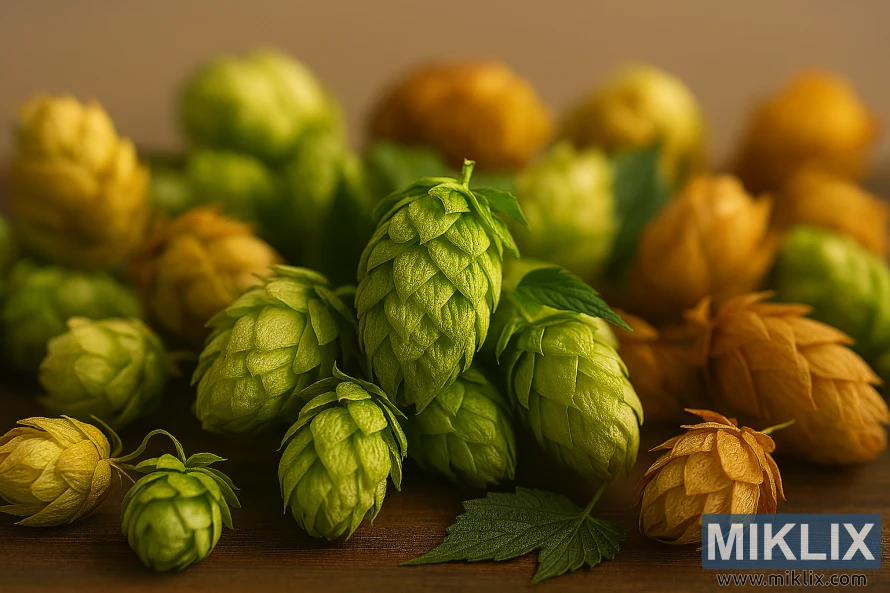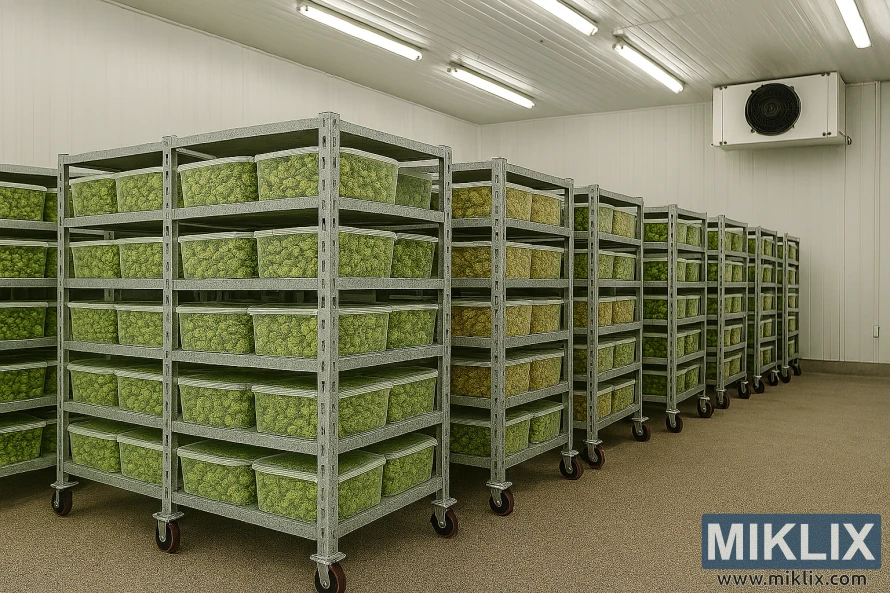Hops in Beer Brewing: Chelan
Published: November 6, 2025 at 11:33:57 PM UTC
Chelan hops, a U.S. bittering hop, were developed by John I. Haas, Inc. in 1994. They are registered as cultivar H87203-1 with the international code CHE. This hop variety is a descendant of Galena, bred for its higher alpha acids.

As a Chelan bittering hop, it boasts around 13% alpha acids. This makes it a dependable choice for early kettle additions. In many recipes, Chelan hops make up about 38% of the total hop usage. Brewers often choose Chelan for its firm bitterness over late-aroma character.
The Chelan hop variety adds subtle citrus and floral notes. However, its primary role in brewing is clean bittering. When Chelan is not available, brewers often substitute it with Galena or Nugget. This is due to their similar bittering profiles.
Key Takeaways
- Chelan hops were released by John I. Haas, Inc. in 1994 (cultivar H87203-1, code CHE).
- Chelan is primarily a high-alpha bittering hop, averaging near 13% alpha acids.
- Commonly used for early additions where Chelan bittering hop character is desired.
- Chelan hops brewing often represents about 38% of hop usage in recipes.
- Galena and Nugget are practical substitutes for the Chelan hop variety.
Introduction to Chelan hops
Chelan hops were introduced in 1994 by John I. Haas Chelan. They were bred to be a reliable bittering hop. The breeding program used Galena as a parent, resulting in H87203-1, also known as CHE.
The history of Chelan hops is rooted in practical brewing needs. It was chosen for its higher alpha-acid content compared to Galena. This gives it a stronger bittering power while maintaining a clean taste. John I. Haas, Inc. owns and licenses Chelan, ensuring its release and promotion.
Chelan is commonly used as a bittering hop in brewing. It's best added early in the boil for a firm, neutral bitterness. Its practical traits make it a go-to choice for brewers seeking dependable alpha acids without floral or citrus notes.
Flavor and aroma profile of Chelan hops
Chelan hops are often employed for bittering, yet they add a soft, aromatic touch that brewers find appealing. The flavor profile is described as mild, with clear citrus and delicate floral notes. These characteristics do not overpower a recipe, making it versatile for brewers.
The aroma of Chelan highlights citrus top notes and subtle floral accents. This combination is ideal for brewers seeking a bright lift without aggressive hop character. It adds a refined touch to beer without dominating the palate.
In tasting panels, descriptors like citrus, floral, and fruity recur. The citrus floral fruity Chelan presence is lively yet restrained. It adds freshness while allowing malt and yeast to remain central, enhancing the overall balance.
When used in whirlpool or late additions, Chelan can introduce gentle fruity esters and light perfume. As a primary bittering hop, its clean bitterness complements a background of mild aroma. This avoids the bold essential oils often associated with other hops.
- Primary traits: mild bitterness, clean finish
- Aroma cues: citrus and floral
- Sensory tags: fruity, light, balanced

Chemical composition and brewing values
Chelan is classified as a high-alpha hop, boasting alpha acids between 12–15%, with an average of 13.5%. This high alpha acid content positions it as a dependable bittering agent for a variety of ales and lagers. The consistent alpha acid level allows brewers to accurately forecast bitterness levels early in the brewing process.
The beta acid content is slightly lower, ranging from 8.5–10%, with an average of 9.3%. The balance between alpha and beta acids in Chelan is often close to 1:1. This ratio facilitates both clean bittering and a lingering herbal character when hops are added later in the brewing process.
Co-humulone, a significant component of alpha acids, accounts for approximately one-third, averaging 33–35%. This high cohumulone content contributes to Chelan's robust, assertive bitterness, distinguishing it from other hop varieties.
Total essential oils average about 1.7 mL per 100 g, with a range of 1.5 to 1.9 mL. Myrcene dominates the oil profile, making up roughly half, followed by humulene and caryophyllene. Minor components like linalool and geraniol introduce subtle floral and fruity notes.
- Alpha acids: 12–15% (avg 13.5%)
- Beta acids: 8.5–10% (avg 9.3%)
- Co-humulone: 33–35% of alpha (avg 34%)
- Total oils: 1.5–1.9 mL/100 g (avg 1.7 mL)
The oil composition typically features myrcene at 45–55%, humulene at 12–15%, and caryophyllene at 9–12%. Minor components like farnesene and other terpenes comprise the rest. This blend provides Chelan with a solid bittering foundation while offering aromatic oils for late additions or dry hopping.
Practical brewing insights highlight Chelan's higher alpha level compared to Galena, positioning it as a more potent bittering option. Despite its high alpha content, Chelan is also valued for its significant hop oils, making it a versatile choice for late additions.
Brewing uses and timing for Chelan
Chelan is primarily a bittering hop. Brewers seek Chelan for stable, clean bitterness in pale ales, lagers, and robust beers.
For predictable alpha acid extraction, use Chelan in early boil additions. Early additions ensure bitterness and minimize hop oil loss. This timing is ideal for 60- to 90-minute boils.
Timing for Chelan additions varies based on your goals. For bitterness, add at the boil start. For a hint of citrus or floral, use a small whirlpool or 5–10 minute late boil addition. Chelan is not a powerhouse aroma hop.
- For bittering-focused recipes: 60–90 minute additions using Chelan bittering use as the base hop.
- For balanced beers: split the charge with a late whirlpool touch to soften bitterness without stealing aroma.
- For aroma: minimal late additions or light dry-hop; rely on other aroma varieties for stronger top notes.
Recipes often allocate a large share to early additions for Chelan. This reflects common dosage statistics and practical brewing experience. Follow these patterns when planning hop schedules.
Timing for Chelan additions in a hop schedule should align with mash and boil plans. Add Chelan early for alpha-driven bitterness. Shift one or two small additions late for mild citrus presence while preserving most bittering power.
Typical beer styles that use Chelan hops
Chelan is a staple in American ales, providing a solid bittering foundation. Its dependable alpha acids and clean bitterness enhance malt and yeast flavors without overpowering them.
Recipe databases frequently list Chelan for session and standard-strength American beers. It's used mainly in boil additions and early whirlpool work. This ensures bitterness control over aromatic punch.
Chelan American ales benefit from its mild citrus and floral notes. These top notes complement a robust bittering profile. This makes it ideal for brewers aiming for balance in hoppy pale and amber ales.
In Chelan IPA usage, the focus is on less aromatic styles. It excels in West Coast–style or traditional American IPAs. These IPAs prioritize bitterness over tropical or resinous aromas.
- American pale ales: base bittering hop to support citrus-forward adjuncts.
- Amber and brown ales: adds clean bitterness and subtle floral lift.
- Bitterness-forward IPAs: Chelan IPA usage for harsh-free IBUs and crisp finish.
- Session ales: keeps balance while allowing lower ABV to shine.
Brewers often choose Chelan for its reliable alpha-acid contribution. It serves as a backbone for bitterness, allowing other hops to add aroma and complexity.
Hop pairing recommendations with Chelan
Chelan is an excellent choice as a stable, high-alpha bittering base. Many brewers pair Chelan with Galena or Nugget for a firm bitter backbone. These hops complement Chelan's mild citrus and floral traits with their assertive backbone.
For aroma and flavor lift, consider pairing Chelan with Citra, El Dorado, Comet, and Bravo. Citra and El Dorado add bright citrus and tropical fruit notes when added late or used in a dry-hop. Comet brings resinous, grapefruit-like tones. Bravo can sharpen bitterness and lend piney depth to the blend.
Chelan blending strategies involve a split role. Use Chelan early for isomerized hop bittering, then add more aromatic varieties late. This preserves Chelan's bittering stability while letting Citra or El Dorado dominate the aroma profile. Dry-hopping with aromatic hops gives a clear fruit-forward character over the Chelan base.
- Galena or Nugget: early addition for firm bittering and structure
- Citra: late or dry-hop for citrus and tropical top notes
- El Dorado: late or dry-hop for pear, stone fruit, and candy-like brightness
- Comet: late addition for grapefruit and resinous hints
- Bravo: balance for piney, firm bitterness when more backbone is desired
When planning recipes, aim for clear roles in the grist and hop schedule. Set Chelan as the bittering anchor at boil, then layer one or two aromatic hops for late additions or dry-hop. This approach to Chelan blending delivers both steady bitterness and pronounced, modern hop aromas.

Dosage guidelines and recipe percentage
Chelan hop dosage hinges on its alpha acids and the role it plays in your brew. With an alpha range near 12–15% and an average of 13.5%, Chelan is ideal for bittering in 5-gallon (19 L) batches. Use measured alpha-acid values to calculate IBUs for precise bitterness.
Chelan's usage rates are similar to other high-alpha varieties. For a 5-gallon pale ale, aim for Chelan as the primary bittering hop. Adjust the weight to achieve your target IBUs, keeping in mind its 12–15% alpha acid range.
When Chelan leads, it should make up about one-third to one-half of the total hop bill by weight. Recipes often use Chelan at a 38% recipe percentage as a median. Start with this figure and adjust based on your desired aroma and bitterness.
Practical steps:
- Calculate IBUs using the actual alpha-acid percentage on the hop label.
- For bittering, add Chelan early with quantities similar to other high-alpha hops in your recipe.
- If Chelan supplies both bitterness and aroma, split additions: larger early dose for IBUs, smaller late additions for flavor.
For homebrew trials, track Chelan hop dosage and final gravity to see how perceived bitterness changes. Record the Chelan usage rates in each batch to refine the Chelan recipe percentage across subsequent brews. Consistent measurement and note-taking will improve repeatability and help match desired profiles.
Comparisons and substitutions for Chelan
Chelan is a direct descendant of Galena, bred for its reliable, high-alpha bittering. It provides clean bittering with a milder aroma compared to many American aroma hops. When comparing Galena vs Chelan, Chelan often shares similar tonal qualities but may have slightly higher alpha acids, depending on the crop year.
When Chelan is out of stock, finding substitutes is straightforward. Galena is the closest match for bittering profiles and aroma balance. Nugget is another viable option for brewers seeking high-alpha performance and robust bittering character.
- Use Galena when you want a near-identical bittering profile and a comparable, slightly earthy aroma.
- Choose Nugget if you need firm bitterness and a touch more resinous character in the finish.
- Adjust dosages by alpha acid: check the current lab values and scale additions so IBUs match your original Chelan target.
Substitutes may introduce minor aroma shifts. Galena vs Chelan may exhibit small differences in floral or faint stone-fruit notes. Nugget vs Chelan tends to be more resinous and assertive on the bitter edge. These differences rarely disrupt a recipe but can alter hop-driven beers like American Pale Ales or IPAs.
To ensure predictable results, perform a small pilot batch when substituting. Record alpha acid numbers and tasting notes. This way, you can refine the switch in future brews.

Availability, formats, and purchasing tips
Chelan hops are available through various hop merchants, craft-brewing suppliers, and retailers like Amazon. Stock levels fluctuate with harvest year and demand. It's crucial to check Chelan hop availability before planning your recipe.
When purchasing, you can opt for Chelan pellet hops or Chelan whole cone, depending on your brewing style and storage preferences. Pellet hops are denser and suitable for most commercial and homebrew setups. Whole cone hops offer a unique handling experience, ideal for dry hopping and traditional brewing methods.
- Ensure to check the harvest year and alpha acid test values on the label to align with your bitterness goals.
- Compare prices across different suppliers to find the best deals, especially for bulk purchases.
- Keep in mind that no commercial Cryo or lupulin powder for Chelan is currently available from major processors like Yakima Chief, BarthHaas, or Hopsteiner.
When buying Chelan hops, verify that the packaging is vacuum sealed or nitrogen flushed to preserve freshness. Chelan pellet hops generally fare better during transport and storage, especially when the cold chain is not ideal.
For homebrewers, confirm Chelan whole cone availability if you prefer handling hops yourself. For larger or late-hop additions, Chelan pellet hops offer more consistent utilization and less trub.
Review supplier test reports and recent crop notes to ensure the alpha acids and oil profiles match your needs. This information is vital for setting the right hop quantities and timing for consistent results when purchasing Chelan hops.
Storage and handling best practices
Chelan hops' oils are volatile, losing their character with heat and oxygen. To keep citrus, floral, and fruity notes intact, store hops cold and away from air immediately after harvest.
Effective hop storage begins with vacuum or nitrogen-flushed packaging. Use sealed bags for pellets or whole cones. Store packages in a dedicated freezer to minimize temperature fluctuations.
- Minimize oxygen: use oxygen-barrier bags and vacuum sealers.
- Control temperature: store at 0°F (−18°C) or colder for long-term life.
- Limit light and moisture: keep hops in opaque containers in dry conditions.
Proper Chelan hop handling on brew day is crucial. Only thaw what you need and avoid prolonged exposure before use. For late additions where aroma is key, use the freshest product available.
- Label packages with pack date and alpha acid value.
- Rotate stock: oldest first to prevent oil and alpha loss.
- Use pellets within the recommended timeframe; whole cones follow the same rules but check for breakage.
Proper storage of Chelan hops ensures bitterness stability for early kettle additions. Aroma retention hinges on careful handling and cold, oxygen-free storage. These practices protect delicate hop flavors, ensuring consistent brews.

Impact of Chelan on finished beer flavor over time
Chelan hops are known for their firm bitterness, thanks to high alpha acids and a co-humulone share near 34%. This balance ensures a direct, clean bitterness that remains consistent during the aging process of Chelan beer.
The total oil content of Chelan is in the low-to-moderate range, approximately 1.7 mL/100g. This means the citrus and floral notes are enjoyable when fresh but fade more quickly than those of high-oil varieties.
Practical brewers can rely on Chelan's bitterness to remain steady, making it a dependable choice for long-conditioned ales. While bitterness perception may soften slightly with malt aging, the hop's foundation remains robust.
To preserve the hop's fleeting aromatics, it's best to add Chelan late in the boil. Alternatively, use hopstand/whirlpool additions or dry-hop with higher-oil varieties like Citra or Mosaic. These methods enhance the perceived hop character over time.
- Alpha-driven bitterness: stable through conditioning and bottle age.
- Low-to-moderate oils: limited long-term aroma persistence.
- Late additions: improve Chelan aroma stability in finished beer.
In mixed blends, Chelan serves as a solid bittering foundation. Meanwhile, aromatic hops carry the evolving bouquet. This strategy maintains clarity in bitterness and extends the perceived freshness of hops during storage.
Practical recipe examples and suggested formulations
Below are clear, adaptable templates for brewers who want to work with Chelan. Use average alpha acids of 13–13.5% to calculate IBUs for early-boil additions. Many Chelan recipes list the hop at roughly 38% of the total hop bill, where it shines as a primary bittering hop.
Keep late additions focused on aroma. Pair Chelan with Citra, El Dorado, or Comet during whirlpool or dry-hop to lift citrus and tropical notes without masking the firm, clean bitterness Chelan provides.
- American Pale Ale (conceptual): Chelan as the early-boil bittering hop. Use aromatic late additions of Citra or El Dorado for bright top notes. Target a balanced IBU that keeps malt support while letting the citrus/fruit finish speak.
- American IPA (bitter-forward): Increase Chelan in the early charge to drive IBUs. Finish with Bravo or Citra additions in the last 10 minutes, whirlpool, and dry-hop to add pungent aroma and a layered profile.
- Bitter / Amber Ale: Use Chelan for a clean, restrained bitterness with a mild citrus lift. Limit late-hop additions to keep malt flavors central and allow Chelan's supporting role to enhance drinkability.
For homebrewers and small craft brewers, a practical Chelan bittering recipe starts with early additions calculated from 13–13.5% alpha acid. Adjust the Chelan percentage in the hop bill downward if you want more hop complexity from late additions.
When scaling these Chelan beer formulations, track the hop bill ratio and note that many documented recipes use Chelan at near 38% of total hops. This keeps bitterness clear and stable while letting paired hops contribute aroma.
Experiment in small batches. Record hop weights, boil times, and whirlpool temperatures. That practice yields repeatable Chelan recipes and refines each Chelan bittering recipe to match your target beer style and desired balance.
Conclusion
This Chelan hop summary highlights its value for brewers aiming for reliable bitterness. Developed by John I. Haas, Inc. in 1994, Chelan is a high-alpha daughter of Galena. It boasts alpha acids in the 12–15% range, offering a mild citrus, floral, and fruity aroma. This makes it ideal for American-style recipes where consistent bitterness is key.
Choosing Chelan hops is a smart move for brewers seeking consistency and cost-effectiveness. It's often used for about a third of the hop bill in certain recipes. This is because it provides firm IBUs while adding a subtle aroma. For those who desire more pronounced flavors or aromas, pairing Chelan with aromatic hops like Citra, El Dorado, or Comet is recommended. Alternatively, substitute it with Galena or Nugget when alpha levels or availability are a concern.
Practical Chelan brewing takeaways include always checking supplier alpha tests and storing hops in a cold, dry environment. Treat Chelan as a bittering backbone rather than a solo aroma star. When used correctly, Chelan offers predictable bitterness with a light citrus-floral lift. This allows more aromatic hops to take center stage.
Further Reading
If you enjoyed this post, you may also like these suggestions:
